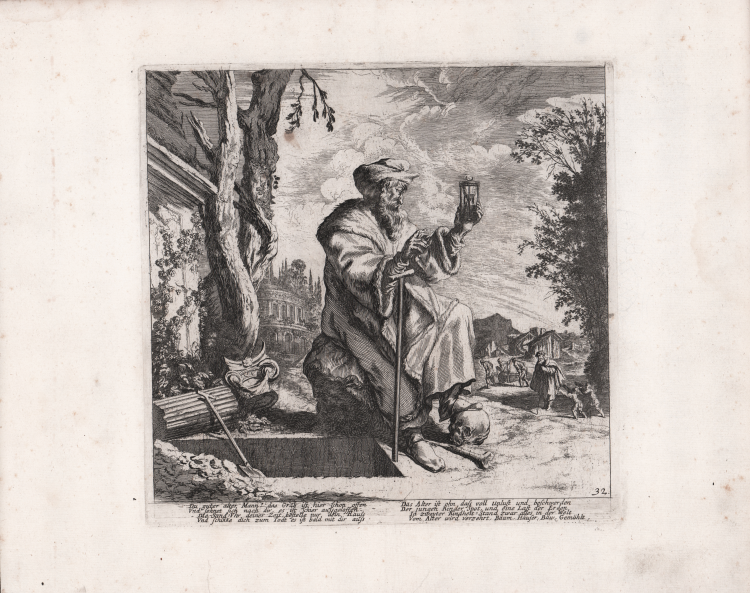




| Reference: | S46639 |
| Author | Melchior KÜSEL |
| Year: | 1682 ca. |
| Measures: | 225 x 220 mm |



| Reference: | S46639 |
| Author | Melchior KÜSEL |
| Year: | 1682 ca. |
| Measures: | 225 x 220 mm |
Etching, ca. 1682, unsigned and without editorial indications.
From a subject by Wilhelm Baur. German text in lower margin; numbered lower right: 32.
The print belongs to a series of allegorical figures, virtues and vices in the album: Johann Wilhelm Baur, Iconographia, 1682.
Allegory of passing time and the concept of impermanence. An old man is seated on top of a large boulder placed under a tree. His right hand holds a staff, while in his left he clutches an hourglass that he watches carefully; under his left foot is a skull. A pit is already dug to his right; elements of classical ruins, such as the capital and column, complete this composition.
Impermanence is a cardinal philosophical concept, which we find mainly related to Eastern philosophies, particularly Buddhism-although there is no lack of indentations in Western philosophy, especially pre-Christian. Impermanence is nothing but the transience of phenomena: everything is transient, everything changes, nothing is eternal. Permanence is an illusion, and the acceptance of this truth-or rather, its concrete and constant perception-allows a serene look at the flow of things. This philosophical paradigm does not imply a nihilistic abandonment of ethical ways: impermanence is a framework, a context - and, among other things, it is one of the fundamental keys to understanding so much of our classical culture. Understanding death and the impermanent nature of all phenomena frees us from fear and sets us free to live fully every moment of our lives.
Melchior Küsel (Augsburg 1626 - 1684) was a pupil of Matthäus Merian the Elder in Frankfurt and on several occasions worked with his brother Matthäus Küsel. He produced several translation engravings, and among the series he produced we can mention: the 146 engravings entitled "Iconographia" (1670); the 42 plates of the "Fido Shepherd" of 1671; the 40 plates of the "Underschidliche Prospecten" of 1681; and the 151 plates of Ovid's "Metamorphoses" of 1681, which were copied from Baur's engraved series of 1639/41.
Magnificent proof, rich in tone, printed on contemporary laid paper, with margins, in perfect condition.
Bibliografia
New Hollstein (Dutch & Flemish) German engravings, etchings and woodcuts, ca. 1400-1700 [Maria Magdalena Küsel to Johann Christoph Laidig] / ed. by Fedja Anzelewsky; comp. by Robert Zijlma, p. 105-107, cat.nr. 332.
Melchior KÜSEL (Augusta, Germania - 17 agosto 1626 - 1684)
|
German engraver. According to Houbraken he made 24 engravings after Johann Wilhelm Baur of the Passion of Christ, but also a series after Ovid. According to the RKD he illustrated bibles. He was probably the brother of the engraver Mathäus Küsel. His daughter Johanna Sibylla married his pupil, the engraver Johann Ulrich Kraus.
|
Melchior KÜSEL (Augusta, Germania - 17 agosto 1626 - 1684)
|
German engraver. According to Houbraken he made 24 engravings after Johann Wilhelm Baur of the Passion of Christ, but also a series after Ovid. According to the RKD he illustrated bibles. He was probably the brother of the engraver Mathäus Küsel. His daughter Johanna Sibylla married his pupil, the engraver Johann Ulrich Kraus.
|